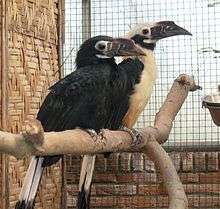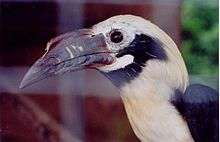Visayan hornbill
| Visayan hornbill | |
|---|---|
 | |
| Pair at Avifauna in Alphen aan den Rijn, Netherlands. | |
| Scientific classification | |
| Kingdom: | Animalia |
| Phylum: | Chordata |
| Class: | Aves |
| Order: | Bucerotiformes |
| Family: | Bucerotidae |
| Genus: | Penelopides |
| Species: | P. panini |
| Binomial name | |
| Penelopides panini (Boddaert, 1783) | |
The Visayan hornbill (Penelopides panini) is a hornbill found in rainforests on the islands of Panay, Negros, Masbate, and Guimaras, and formerly Ticao, in the Philippines. It formerly included all other Philippine tarictic hornbills as subspecies, in which case the common name of the 'combined species' was shortened to tarictic hornbill.
Description

The adults show sexual dimorphism. The male has a creamy-white head and neck, a white upper chest, a reddish-brown lower chest and uppertail-coverts, and a creamy-white buff tail with a broad black tip. The bill and casque are blackish; the former with yellowish ridges. The bare ocular skin is pinkish-white. The tail and bill of the female resemble that of the male, but otherwise the plumage of the female is black, and the ocular skin is blue.
Diet and behavior
Visayan hornbills live in groups and frequent the canopy of rainforests. These birds are noisy and emit an incessant sound that sounds like ta-rik-tik, hence the name. Despite their noise they are difficult to find, being well camouflaged by the dense foliage.
The principal food of Visayan hornbill is fruit. It also eats insects, beetles, ants and earthworms (rarely).
Subspecies
There are 2 currently recognized subspecies:[2]
Conservation

This is a highly endangered species. The total population is estimated at 1800 individuals. There has been a heavy decline in population due to hunting and loss of habitat caused by deforestation. The subspecies ticaensis was described as "abundant" in 1905, but almost the entire forest on the island was replaced by plantations and settlements in the 20th century. The last time the Ticao tarictic was seen was in 1971, and it is now likely to be extinct. If confirmed, this is the first taxon of hornbill to go extinct in recorded history; many other taxa in the family are now at risk.
Captivity
This species has just been imported from Panay in the Philippines by Chester Zoo, England. There are two pairs at Chester, and two pairs at Avifauna in the Netherlands, amongst other collections.
In the past, the Los Angeles Zoo has bred this species, but it is not known whether these birds were pure Penelopides panini panini, so it may not be the first captive breeding of this species; that title may go to a breeding centre on Panay, where Chester's birds came from. The Chester zoo has bred this species.
References
- ↑ BirdLife International (2013). "Penelopides panini". IUCN Red List of Threatened Species. Version 2013.2. International Union for Conservation of Nature. Retrieved 26 November 2013.
- ↑ Gill, F.; Donsker, D., eds. (2014). "IOC World Bird List (v. 5.3): Todies, motmots, bee-eaters, hoopoes, wood hoopoes & hornbills". Retrieved 19 October 2015.
- Kemp, A.C. (2001). del Hoyo, J.; Elliott, A.; Sargatal, J., eds. Family Bucerotidae (Hornbills). Handbook of the Birds of the World. Vol. 6. Mousebirds to Hornbills. Barcelona: Lynx Edicions. pp. 436–523. ISBN 84-87334-30-X.
External links
| Wikimedia Commons has media related to Penelopides panini. |
| Wikispecies has information related to Penelopides panini |
